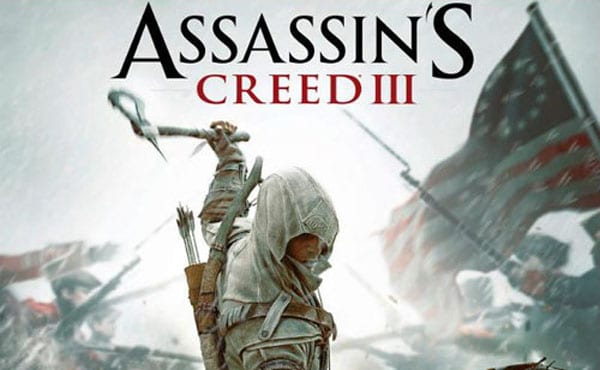
What do you do when the enemy is bigger than anything you’ve ever known? What do you do when powers beyond all understanding conspire to destroy all? You do everything you must. Desmond Miles has spent every moment since his capture working to understand his past. Who are the Templars really? What does the order of Assassins have to do with the The First Civilization – a group seemingly from the distant past, and their insistence that the end of the world is coming? With the Apple of Eden in hand, Desmond and his friends go to their new hidden base and try to discover how they will stop the predicted solar event that threatens to destroy all life on Earth. Once again, the key to the future lies in the past.
A quick note about my review – I will not be discussing major points about the storyline as there is so much to learn and enjoy that discovering it on your own is half of the fun. When I do target something specific, I’ll try to do it in as general a way as I can.
The game opens with one of the coolest tutorial levels in recent memory. A British assassin named Haytham Kenway pops in for an evening at the opera house, only his aim isn’t to enjoy the play but to make sure somebody else does not. After teaching Desmond the basics of climbing in the upgraded Animus 3.0, Haytham is tasked with silently taking the life of a single man in a room filled with hundreds of people. I don’t want to spoil it for you, but this singular moment is just a taste of what this game has to offer. Let’s talk about what makes it possible.
“He must be late, and she must be beautiful!”
[singlepic id=9612 w=320 h=240 float=left]Assassin’s Creed III runs on an engine called AnvilNext, a new version of the engine behind previous titles. The team had specific goals in mind for this sequel, and they needed some upgrades to do it. The new engine has given them even larger sprawling landscapes than in previous titles, more dense with forests, animals, people (later you’ll see thousands of people on the battlefield), and a huge bump to environmental effects. The game takes place in parts of America that have seasonal changes and spans several years, so obviously the team wanted to have all four seasons. While it’s easy to give players different colored leaves to signify Fall, it’s difficult to handle snow properly. Well…not for AnvilNext.
During memory sequences that take place during the winter, the player will find themselves hip-deep in heavy snowfall, having to pull their boots out of the thick blanket. This has an impact on gameplay as it also can be used to track. Animals may be light footed (in most cases) enough to not leave tracks, but people generally leave a pretty obvious trench as they plow through snow. Additionally, this makes combat difficult at best as the rapid movements needed to avoid musket fire is severely limited. Staying with environments a moment, the game does a fantastic job of depicting rain, heavy fog, and thick smoke. While those items don’t affect gameplay, the immersion factor is high. It’s not all cold-looking snow and freezing rain though – AnvilNext has also taken facial work to a new level.
Escaping the Valley
There is a concept in robotics and 3D animation called the “Uncanny Valley”. This concept stated simply is the point where a human being depicted reaches a point where they look and act almost exactly like human beings, but there is something just slightly ‘off’ about them, causing a fairly jarring reaction – something is just not quite right. When Half-Life 2 came out, people talked a lot about how great the animation system for the eyes were, but when they started spinning around in skulls like human slot machines, that quickly turned into a discussion on how creepy they were. As animation techniques and technology has improved, this Valley has become smaller, and if titles like Beyond and Quantic Dreams recent tech demo are any indication, development houses are looking to close the Valley for good. From the first Assassin’s Creed title, it is clear that Ubisoft has been striving similarly against the Uncanny Valley, and nowhere is that more clear than up-close facial fidelity and animation. As fantastic as previous titles looked, Assassin’s Creed III is something altogether different. Full body inverse kinematics, blended animations, and motion capture come together with Havok to create movement that is natural and fluid, with Connor’s movements being especially smooth.
Beyond body language mechanics and the sway of clothing, there are subtleties of movement called micro-expressions in your face that are often the source of contention when something looks slightly off in animation. Smiling is not something that happens just at the mouth, as it pulls on the jawbone, pulls the ears slightly, and often has a reaction in the eyes, cheeks, eyelids, and much more. Something as simple as narrowing ones eyes to convey a hostile tone can require dozens of small and subtle changes in the face that just aren’t well captured in most games.[singlepic id=9622 w=320 h=240 float=right]
The Assassin’s Creed III team has spent painstaking hours ensuring that those micro-expressions are captured, and it has a huge impact on the connection with the characters. Stoic Indians that could have come across looking wooden instead look proud, and only their smallest bits of expression betray their true feelings. Seemingly friendly characters show us their vicious underside as their face twists in acts of cruelty. The character models for faces must push into the tens of thousands of polygons, all without becoming bogged down in the kind of realism that would require cuts in other places. Whether it be up close or in a field of thousands, AnvilNext has pushed what we might expect from traditional animation to its limits…and maybe beyond.
The clothing in the game is similarly fantastic. Tassels on leather whip in the wind, the textures on the cloth are vibrant and detailed. The crumple of an old worn hat, or the incredible detail in a full outfit show the amount of love put into the game. There are some areas that still stick out – horse manes look somewhat odd, and in one instance some human mouths stopped moving (no talking horses here), making for some odd conversation.
There is one area that does suffer a bit, unfortunately, and that’s framerate. It is clear that AnvilNext is pushing the hardware as hard as possible, and (infrequently) sometimes when the action gets fast and furious, the framerate suffers a bit. It’s a stutter more than a halt, but certainly present. Occasionally there is a bizarre hiccup in the Havok engine. Stabbing a group of enemies that were near the edge of a cliff had them suspended in mid air, and then falling straight down Wile E Coyote style. Hilarious, but immersion breaking.
“I watch them fight and die in the name of freedom”
[singlepic id=9618 w=320 h=240 float=left]Combat mechanics in previous Assassin’s Creed titles certainly had finesse but you could always win by simply hacking at most enemies – this has changed. While there are certainly lower ranking officers and such that will succumb to a brute force assault, it doesn’t take long before you’ll have to start paying attention to parrying, dodging, breaking guard, and positioning more than you have before. To help Connor with this new challenge, dual-wielding has been brought to the game. A pair of hidden blades, a tomahawk with a head shaped like the symbol of the order, flintlock pistols, sabers, rope darts, a bow, poison, and more are at his disposal, as well as any weapon (such as a rifle with a bayonet) you can strip from an enemy. As brutal as any of the previous members of The Brotherhood were, Connor is more so. The combat upgrades shine when you counter one enemy only to use him as a shield against a second, and then set a third enemy on his knees with a short strike and a slice across his neck. These moments integrate perfectly into the flow of combat as semi-cinematic moments that make Connor look like a well-trained member of The Brotherhood.
Target locking an enemy has been made an automatic thing, simply training on the enemy you have highlighted rather than having to hold a button to stay locked on. The combined effect is that combat is faster and more natural for somebody with Connor’s level of training. Combat animations have Connor taking out enemies in hundreds of unique and context-sensitive ways without feeling like you have to drag somebody over to the context trigger. If Connor is facing an enemy in a tavern he might cut down his enemies the old fashioned way, or he may shoulder-throw him into a nearby table, rendering that enemy unconscious. This ties directly into the reaction system that is present throughout the game.
At any point you may get a button prompt on the screen, asking you to react, and then counterattack. Pressing Square executes Connor’s target, whereas Circle bodily throws the enemy to the dirt. Triangle lets you mix in your secondary weapon (i.e. pistol, axe, etc.), whereas X issues a quick stun to set up more elaborate attacks. This extends past soldiers and into hunting grounds as well, as occasionally Connor is caught off guard by a wolf, bear, or other creatures that may also be hunting. These quicktime events aren’t overly frequent, thankfully, striking a balance between necessity for immersion and nuisance.
One of the bigger additions to the series is the rope dart. Chinese in origin, the rope dart is a restraining and execution device in Connor’s pouch. Capable of halting an enemy and pulling them backwards to a waiting blade or pulled fist, the rope dart also ties into the verticality in the game. Connor is capable of leaping from tree to tree in the same way that Ezio is able to scramble across rooftops. In that way, he can use his rope dart to hook an enemy and choke them to death, or for a faster solution, pull them upwards to hang them by the neck until dead. It ties perfectly into the arsenal and becomes fairly indispensable almost as soon as you receive it.[singlepic id=9616 w=320 h=240 float=right]
Animus 3.0 and making money
Taking a break from Connor for a moment, Desmond’s compatriots have worked together to upgrade his method of reaching into the world of his ancestors. Desmond is once again given objectives to accomplish, as well as sub-objectives. During maritime missions this could be use of a specific cannon type, preventing damage to the ship, or a requirement to ram a certain number of ships. On the ground, it could be acting before the death of an innocent, reaching an objective before a certain timer expired, or remaining in open combat for less than 15 seconds. These objectives can be re-attempted, as before, by replaying missions. Since there are checkpoints in the missions, you can also bounce back to the previous checkpoint or replay the entire mission.
Back inside the Animus, Connor has to earn money to help upgrade his homestead, his ship, and fill his pockets with ammo and weapons. To this end, he can hunt and skin animals using snares or more traditional attack means. The skins are damaged by guns or more vicious methods, so careful choice of weapons gives you more usable parts and pelts which can be sold for money. As you befriend artisans you can use their production as fodder for trade routes that is not unlike the missions you’d send your brothers on in the previous game. The land convoys can sell your items to merchants in town. There is a certain amount of travel time (in real world minutes) as well as a percentage of risk and taxes associated deducted, to determine your total profit. Additionally, the more artisans you recruit to your cause, the more items you’ll have access to for trade or for crafting.
[singlepic id=9613 w=320 h=240 float=left]The Tower Defense mode in the previous game didn’t go over well with everyone. To that end, it has been replaced with Naval Missions. Hiring a crew, maintaining and adding ammunition types to your cannons, and patrolling the Eastern Seaboard becomes Connor’s personal hobby, and it is awesome. Graphically it is absolutely gorgeous, and the gameplay is rock solid. Setting sail, battling against dozens of ships of all sizes, and having full control of the ship is fantastic, and the thrill of taking down a Ship of the Line or a Frigate can’t be overestimated. Choosing between using Swivel Cannons (smaller but more precise) can turn the tide of battle, but launching a volley through a cluster of ships can turn them into smouldering splinters far faster, sending them quickly to the bottom of the deep.
You’ll once again retain and command a stable of Assassins, sending them on missions for experience and profit, though you’ll earn them less quickly than before. As Boston is no stranger to forts, you’ll be once again freeing strongholds from enemy possession. You’ll be charged with the taking of several forts over the course of the game, with sub-objectives like destroying powder reserves, killing the fort’s Captain, and lowering the flag to finally seize it from the temporary owners.
Paranoia at its best – multiplayer
Ubisoft Annecy and Ubisoft Bucharest have returned, fresh from the fantastic multiplayer efforts in Revelations and Brotherhood, to bring the multiplayer to life. Framed as a new “Game” from Abstergo Entertainment, the multiplayer starts with creating a profile. This includes selecting a “Patron Picture”, many of which are locked by level in multiplayer or specific sections in single player. There are 78 in all. After that, you’ll go through a short tutorial section of the game to teach you the basics of this mode. There are a total of 12 characters to choose from (other than ones you might have gotten with a special pre-order) and as before you’ll have to identify enemies in the crowd and take them out. A portrait in the upper right corner gives you an idea of whom you seek. Killing your target, and not killing civilians, gives you points. Killing civilians causes you to show that you are not an NPC. Given that you are unable to execute a kill command for a short while, but your target can still stun you, it’s better to be sure than to be hasty. There are a total of three Introductory Sessions that’ll help you hone your skills, as well as a playground where you can practice against the AI solo.
There are two new modes to enjoy in addition to the Deathmatch and Team Deathmatch modes from previous games. The first is called “Wolf Pack”. In Wolf Pack, you work with a team to kill designated targets to maximize the score before the timer reaches zero. This cooperative mode is likely where you’ll find me spending the bulk of my time. There are 12 Archetypes you’ll be tasked with taking out in this mode, each with a special set of skills and powers, such as the ability to use disguises, throw firecrackers as distractions, or a rapid stun attack.
The second mode is called The Abstergo Story. This plays as a sort of meta story that almost pokes fun at the concept of a game within a game. Each section is unlocked by performing multiplayer feats in other areas of the multiplayer universe, so it’ll take some time to unlock them all.[singlepic id=9611 w=320 h=240 float=right]
There are 99 prestige rewards, 33 ability, 13 style, 18 assassination, and 26 mode challenges in all, as well as 38 accolades and 49 levels to attain. This mode adds a lot of content to an already impressively long game.
Breathing life into Colonial America with Music
Colonial America has a very specific sound associated with it. British influenced harpsichord mixed with the American tradition of violins and what could only be described as “Frontier Frivolity”. Beyond that, honoring Connor’s heritage, there are also music tracks that feature authentic Indian chanting. Whether these resonate with you or not, there is no arguing that Ubisoft went above and beyond to ensure authenticity.
The voice acting for Assassin’s Creed has always been rock solid, and this title is no exception. Noah Watts turns in an excellent performance as Connor, John De Lancie tackles the role of Desmond’s father, and Eliza Schneider handles the voicework of Rebecca Crane once again. Getting to hear the Indian tribal language of Connor’s people spoken in a natural way is an important part of the immersion factor. Similarly, the subject of slavery is handled in a serious and respectful way. All in all, the voice cast turns in rock solid performances. I don’t want to ruin all of the incredible people from America’s history that you will meet, but if you know anything of the age you’ll likely have heard of almost everyone in the game. Since the Animus database is filled by Shawn Hastings, it’s filled with a metric ton of real-world facts with his snarky British slant. It gives the player a lot of history without making it into a history lesson.
Requiescat in pace
[singlepic id=9610 w=320 h=240 float=left]The Assassin’s Creed series has grown a lot since its inception 2007. We’ve seen fan feedback improve so much of the game, and somehow remain true to the roots of the series. Seeing the addition of things like fast travel, a secondary economic mechanic, two-stage lockpicking (introduced in this title), delivering secret letters, secondary assassination missions, the hunting society (find and kill unique things for fun and profit!), gambling (this title gets Fanorona and Nine or Twelve Men’s Morris, aka “Cowboy Checkers”), collection elements (Almanac pages here), ship to ship combat, and an ever-evolving storyline keeps players coming back, and with good reason. Certainly we have a few bugs to contend with, but there is so much content in this title, so much to explore and experience, that it transcends anything I’d have to say about it. Freerunning has taken on new life with Connor’s ability to flit through the trees, and the new weapons hem nicely into the freedom and wealth of options of the series. While Assassin’s Creed III is likely the last of the series we’ll see on this generation of consoles, it embodies everything we’ve come to expect from Ubisoft’s incredible games. I can personally guarantee it’ll see the top of many “Game of the Year” lists, perhaps even our own – Assassin’s Creed III is a masterpiece.
Ron Burke is the Editor in Chief for Gaming Trend. Currently living in Fort Worth, Texas, Ron is an old-school gamer who enjoys CRPGs, action/adventure, platformers, music games, and has recently gotten into tabletop gaming.
Ron is also a fourth degree black belt, with a Master's rank in Matsumura Seito Shōrin-ryū, Moo Duk Kwan Tang Soo Do, Universal Tang Soo Do Alliance, and International Tang Soo Do Federation. He also holds ranks in several other styles in his search to be a well-rounded fighter.
Ron has been married to Gaming Trend Editor, Laura Burke, for 28 years. They have three dogs - Pazuzu (Irish Terrier), Atë, and Calliope (both Australian Kelpie/Pit Bull mixes), and an Axolotl named Dagon!

See below for our list of partners and affiliates:

























